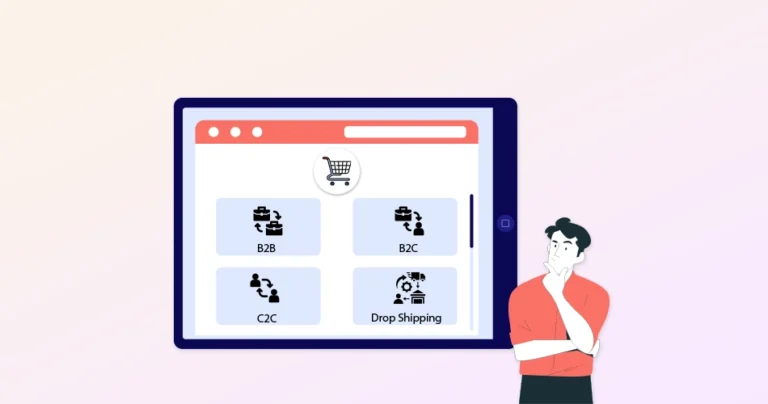Let’s say you’ve decided to start a new eCommerce business. Then one of the first stages to tackle is selecting the best eCommerce business model. This serves as the foundation for your entire operation, dictating everything from your target audience to your inventory management strategy.
From the classic B2C model to innovative C2C platforms connecting individuals, there’s a whole spectrum of possibilities waiting to be explored. Each model comes with its own advantages and challenges, and understanding them is crucial for building a successful online store.
Our eCommerce experts have created this comprehensive guide to explain the different eCommerce business models. You can choose a suitable one and launch your enterprise.
Common eCommerce Business Models
From directly selling to consumers to facilitating transactions between individuals, there’s a spectrum of eCommerce models. Each of them come with its own unique characteristics and target audience.
Business-to-Consumer (B2C)
B2C is a widely used eCommerce model where businesses sell products or services directly to individual consumers. This eliminates the need for intermediaries, so businesses can interact and transact with their target audience directly.
However, success in this competitive landscape requires careful planning, effective marketing strategies, and exceptional customer service.
Key Features
- High profit margins compared to B2B sales.
- Direct control over branding and customer relationships.
- Requires strong marketing and customer service strategies.
- Wide range of product categories possible.
Examples: Amazon, Shopify stores, online clothing retailers.
Consumer-to-Consumer (C2C)
C2C is an eCommerce model where individual consumers buy and sell goods or services directly from each other. The sales are often facilitated by a third-party platform. This model has gained immense popularity with the rise of online marketplaces. It offers a flexible and accessible way for individuals to participate in the digital economy.
However, it’s crucial to be aware of potential challenges regarding product quality, security, and customer service when participating in this model.
Key Features:
- Low barrier to entry for sellers.
- Vast potential customer base.
- Platform facilitates transactions and provides security measures.
- Limited control over product quality and customer experience.
Examples: eBay, OLX, Etsy, Airbnb.
Business-to-Business (B2B)
The B2B model refers to the sale of products or services between businesses, rather than directly to individual consumers. This encompasses a wide range of transactions, from raw materials suppliers to software companies providing solutions to other businesses.
However, success in this model requires a strategic approach and a focus on building strong relationships. Plus, you need to provide solutions that meet the specific needs of its clients.
Key Features:
- Larger order volumes and higher transaction values.
- Longer sales cycles and complex decision-making processes.
- Focus on building strong partnerships and providing customized solutions.
- Often requires specialized marketing strategies targeting specific industries.
Examples: Wholesale suppliers, software companies selling to other companies.
Dropshipping
Dropshipping is a retail fulfillment method where the store owner doesn’t hold any physical inventory. Instead, when a customer places an order, the store forwards the order details and customer information to a third-party supplier. This supplier then directly ships the product to the customer.
However, it’s crucial to carefully choose reliable suppliers and prioritize marketing and customer service. You also need to manage expectations regarding profit margins and potential challenges.
Key Features:
- Low upfront costs and minimal inventory management.
- Scalability and flexibility in product offerings.
- Limited control over product quality and shipping times.
- Lower profit margins compared to traditional retail models.
Examples: Many online stores selling a wide variety of products.
Subscription eCommerce
In the subscription eCommerce model, customers pay a recurring fee (typically monthly, quarterly, or annually) to receive access to products or services on a regular basis. This model has gained significant popularity in recent years, offering benefits for both businesses and consumers.
However, success requires careful planning, effective customer acquisition and retention strategies. And you need to be committed to delivering consistent value to subscribers.
Key Features
- Predictable revenue streams and customer lifetime value.
- Fosters customer loyalty and engagement.
- Requires consistent product/service innovation and value delivery.
- Can be challenging to acquire new subscribers.
Examples: Subscription boxes, streaming services, software as a service (SaaS) companies.
Marketplace
The marketplace model is a popular approach in eCommerce where an online platform facilitates transactions between multiple independent sellers and a vast pool of potential buyers. It acts as a virtual meeting ground, offering a diverse range of products and services in one centralized location.
However, success requires a focus on attracting a large user base and maintaining platform quality and security. Plus, you need to provide valuable services to both buyers and sellers.
Key Features
- Wide variety of products and sellers in one place.
- Large customer base attracted by the diverse offerings.
- A marketplace owner generates revenue through transaction fees or subscriptions.
- Requires strong platform management and marketing strategies.
Examples: Amazon Marketplace, Etsy, eBay.
White Labeling
White labeling is a business model where a company purchases a product from another manufacturer and rebrands it under their own brand. This essentially means the original manufacturer remains hidden, while the rebranding company takes full ownership of the product’s marketing and customer experience.
However, it’s crucial to carefully choose reliable manufacturers and maintain control over brand image and customer experience.
Key Features
- Faster product launch with minimal product development costs.
- Lower inventory risk compared to manufacturing your own products.
- Less control over product quality and brand perception.
- Competition with other white-labeled products.
Examples: Many private label products sold in supermarkets or online stores.
Crowdfunding
Crowdfunding is a method of raising capital for projects or businesses. In this model, you collect small contributions from a large number of individuals, typically through online platforms. It empowers entrepreneurs and creators to access funding beyond traditional avenues like banks or venture capitalists.
However, success requires careful planning and effective campaign management. And you need to be aware of the challenges like overcompetition, platform fees, etc.
Key Features
- Potential to raise capital from a large pool of potential investors.
- Builds community engagement and pre-orders for new products.
- Requires effective marketing and clear communication of the project goals.
- Success depends on attracting a sufficient number of backers.
Examples: Kickstarter, Indiegogo.
You can select the most suitable eCommerce business model according to some key factors. These include the nature of the product, inventory requirements, target audience, business goals, technical expertise, competition, etc. You can also opt for our eCommerce consulting services for more info on which model will be suitable.
How to Choose the Best eCommerce Business Model?
Choosing the best eCommerce business model depends on various factors including your product or service, target market, resources, and goals. Here’s a guide to help you make an informed decision:
Step 1: Understand Your Product/Service
Consider the nature of what you’re selling. Is it physical goods, digital products, or services? Different business models are better suited for different types of offerings.
Step 2: Know Your Target Market
Understand your customers’ preferences, behavior, and buying habits. Some demographics may prefer subscription services, while others might prefer traditional retail or marketplace platforms.
Step 3: Assess Your Resources
Evaluate your financial resources, manpower, and infrastructure. Some models require significant upfront investment and ongoing operational costs, while others can be started with minimal capital.
Step 4: Consider Scalability
Think about the scalability of your chosen model. Will it allow you to grow your business efficiently as demand increases? Scalability is crucial for long-term success.
Step 5: Evaluate Competition
Research existing competitors in your niche and analyze their business models. Identify gaps or areas where you can differentiate yourself to stand out in the market.
Step 6: Factor in Regulatory and Legal Considerations
Certain business models may have specific legal or regulatory requirements. Ensure compliance with laws related to taxes, data protection, consumer rights, etc.
Step 7: Test and Iterate
It’s often beneficial to start with a small-scale implementation of your chosen model and gather feedback from customers. Use this feedback to iterate and refine your approach.
Step 8: Consider Customer Experience
Consider how each model impacts the overall customer experience. Choose a model that aligns with your vision for delivering a seamless and enjoyable shopping experience.
Step 9: Take into Account the Long-term Viability
Assess the long-term viability and sustainability of the chosen model. Will it remain relevant and profitable as market trends evolve? Keep in mind there’s no single “best” model. It’s okay to experiment and adjust your approach as you gain more experience and insights into what works best for your business. You can also consult with our eCommerce development experts to know more about models.
Conclusion
Selecting the most suitable eCommerce model for your business venture requires careful consideration of several key factors. That includes your product type, target market, resources, and business goals.
The most common eCommerce business models include:
- B2C (Business to Consumer)
- C2C (Consumer to Consumer)
- B2B (Business to Business)
- Dropshipping
- Subscription eCommerce
- Marketplace
- White Labeling
- Crowdfunding
Need help with implementing any of the above-mentioned eCommerce models? Then let’s have a consultation today!
FAQs on eCommerce Business Models
Q1. What is the most profitable eCommerce model?
There’s no single most profitable model. Profitability depends on various factors like product margins, competition, operational costs, and marketing strategies. However, subscription models and white labeling often offer higher potential profit margins.
Q2. Do I need technical skills to start an eCommerce business?
While technical skills can be beneficial, many platforms offer user-friendly interfaces that make it easier for beginners. However, having basic computer skills and the willingness to learn new software are helpful.
Q3. Can I combine different models?
Yes, businesses often combine elements of different models. For example, a B2C store might offer a subscription service for exclusive products or utilize dropshipping for certain items.





